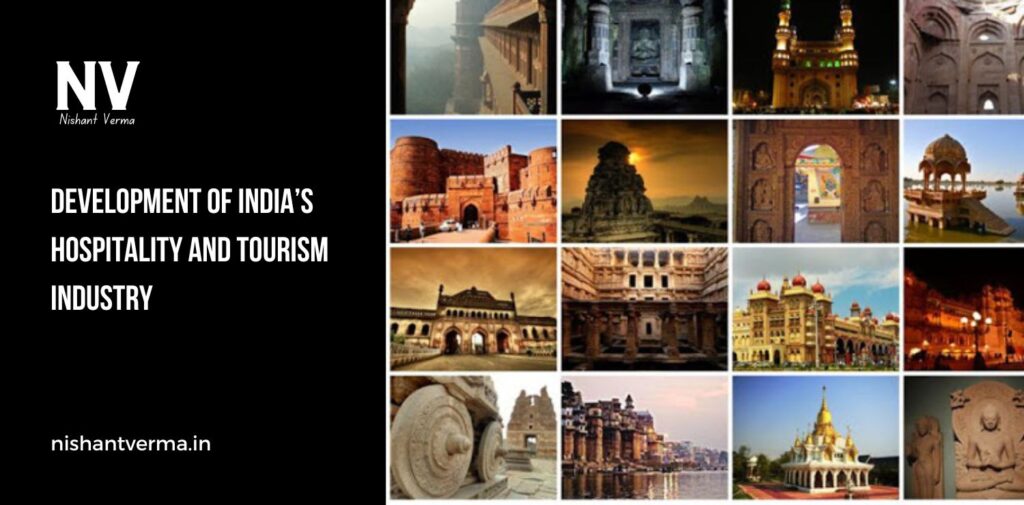India is a land of great diversity. It is a country with a rich cultural heritage, vast landscapes, beautiful monuments, and a long history. In the past few decades, India has become one of the most popular tourist destinations in the world. This is because of the growth and development of India’s hospitality and tourism industry. But how did this industry grow? How did India become a top destination for tourists from all over the world? Let’s take a simple look at how this amazing journey began.

What is Hospitality and Tourism?
Before diving into the development of this industry, let’s understand what hospitality and tourism mean.
- Tourism is when people travel from one place to another for leisure, fun, business, or education. They visit different places to experience new cultures, food, traditions, and natural beauty.
- Hospitality refers to how people are treated when they visit places like hotels, restaurants, and resorts. It is the care and service given to guests, making them feel welcome and comfortable during their stay.
In India, the hospitality and tourism industry includes hotels, restaurants, airlines, tour operators, and more, all working together to make tourists’ experiences memorable.
The Early Days: Before Independence
Before India became independent in 1947, tourism was not a big industry. The country was under British rule, and most people from outside India visited for trade, business, or to study. There were not many hotels or tourist services like we have today. The few hotels that existed were small and not well-developed.
Many foreign visitors came to India to see the beautiful palaces, temples, and historical sites, like the Taj Mahal, Jaipur’s palaces, and the temples of South India. However, the country’s tourism industry was not as advanced as it could have been. The hospitality sector had a lot of room for improvement.
After Independence: The Beginning of Growth
When India gained independence in 1947, the government realized that tourism could play an important role in the country’s economic growth. It was not just a way to bring in foreign visitors, but also a means to showcase India’s rich culture and history to the world.
The first big step towards developing tourism in India was in the early 1950s, when the government established the India Tourism Development Corporation (ITDC). This body was created to improve the country’s tourism infrastructure, build new hotels, and promote India’s culture abroad.

Key Developments in the Hospitality and Tourism Industry
- Building Modern Hotels and Resorts: One of the most important developments in India’s tourism industry was the building of more modern hotels and resorts. In the 1950s and 1960s, many new hotels were built in major cities like Delhi, Mumbai, and Bangalore. These hotels were built to international standards, offering a better experience for both Indian and foreign tourists. Luxury hotels like The Taj Mahal Palace in Mumbai and Oberoi Grand in Kolkata became famous worldwide. Over time, more hotels were built across the country, especially in popular tourist areas. Beach resorts, mountain retreats, and heritage hotels began to grow in popularity.
- Introduction of Tour Packages and Travel Agencies: In the 1970s, tour operators and travel agencies started offering ready-made tour packages for people who wanted to explore India. These packages included transportation, accommodation, and guided tours to popular tourist sites. This made it easier for people, especially foreign tourists, to visit different parts of India without having to worry about the details of planning a trip. The rise of travel agencies like Thomas Cook helped spread awareness about India as a travel destination. They offered packages to famous places like the Taj Mahal, Rajasthan, Kerala backwaters, and the Himalayan mountains.
- Government Support and Promotion: The Indian government played an important role in the growth of the tourism industry. In 2002, the government launched a campaign called “Incredible India”. This campaign was aimed at promoting India as a top tourist destination. The government started advertising India’s rich culture, history, and natural beauty to the world. It featured beautiful images of India’s monuments, temples, wildlife, and festivals. The Ministry of Tourism also created policies and schemes to improve the infrastructure, transport, and facilities for tourists. The introduction of e-visa facilities for certain countries made it easier for foreign tourists to visit India.
- Rise of Medical and Wellness Tourism: Another important development in India’s tourism industry was the rise of medical tourism. Many people from around the world started visiting India for affordable and high-quality medical treatments. India has become a popular destination for surgeries, treatments, and wellness programs. Hospitals in cities like Delhi, Mumbai, and Bangalore attract patients from the United States, Europe, and other parts of the world. Along with medical tourism, India’s ancient wellness practices like yoga and Ayurveda became popular. Tourists began visiting India for spiritual retreats and wellness programs. Cities like Rishikesh and Kerala became famous for yoga and Ayurvedic treatments.
New Trends in India’s Tourism Industry
In recent years, India’s tourism industry has seen new trends that have made it even more popular. These trends have changed the way people travel and experience India.
- Adventure and Eco-Tourism: Tourism in India is no longer just about visiting historical sites. Adventure tourism has seen a rise, with many people coming to India for activities like trekking, paragliding, and white-water rafting. The Himalayas, Goa, and the Northeastern states are famous for adventure tourism. Along with adventure tourism, eco-tourism has become a big part of the industry. People now travel to India to experience its wildlife, forests, and natural beauty. The Ranthambhore National Park in Rajasthan and Jim Corbett National Park in Uttarakhand attract tourists who love nature and wildlife.
- The Growth of Digital Platforms: Technology has played a big role in the development of India’s hospitality and tourism industry. Today, tourists can easily book flights, hotels, and travel packages online through digital platforms like MakeMyTrip, Yatra, and Cleartrip. These websites and apps have made travel planning much easier for people both in India and abroad.
- Rising Domestic Tourism: While international tourism has always been important, domestic tourism in India has grown significantly. More and more Indians are traveling within their own country to explore new places. With increased access to better transport, affordable hotels, and online booking services, people are discovering the beauty of India’s lesser-known destinations.

Challenges and Opportunities
Even though India’s hospitality and tourism industry has grown tremendously, there are still some challenges. These include issues like poor infrastructure in some areas, lack of cleanliness, and the need for better training of workers in the hospitality sector.
However, the opportunities are endless. With the increasing number of tourists from around the world, India’s tourism industry has the potential to grow even more. The government and private companies are working together to overcome challenges and make the tourism experience better for everyone.
Conclusion
The development of India’s hospitality and tourism industry has been a remarkable journey. From the early days after independence to the rise of new trends like adventure tourism and wellness retreats, India has become a global leader in tourism. With its rich culture, diverse landscapes, and welcoming hospitality, India will continue to attract millions of tourists from around the world.
As more people travel to India, the hospitality and tourism industry will only grow stronger, creating new opportunities for people in the country. Whether you want to visit historical monuments, relax at a beach resort, or experience the spiritual side of India, there is something for everyone in this beautiful land.




